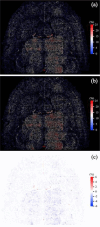This is a preprint.
Imaging Intravoxel Vessel Size Distribution in the Brain Using Susceptibility Contrast Enhanced MRI
- PMID: 40196141
- PMCID: PMC11975306
Imaging Intravoxel Vessel Size Distribution in the Brain Using Susceptibility Contrast Enhanced MRI
Abstract
Vascular remodelling is inherent to the pathogenesis of many diseases including cancer, neurodegeneration, fibrosis, hypertension, and diabetes. In this paper, a new susceptibility-contrast based MRI approach is established to non-invasively image intravoxel vessel size distribution (VSD), enabling a more comprehensive and quantitative assessment of vascular remodelling. The approach utilizes high-resolution light-sheet fluorescence microscopy images of rodent brain vasculature, simulating gradient echo sampling of free induction decay and spin echo (GESFIDE) MRI signals for the three-dimensional vascular networks, and training a deep learning model to predict cerebral blood volume (CBV) and VSD from GESFIDE signals. The results from ex vivo experiments demonstrated strong correlation (r = 0.96) between the true and predicted CBV. High similarity between true and predicted VSDs was observed (mean Bhattacharya Coefficient = 0.92). With further in vivo validation, intravoxel VSD imaging could become a transformative preclinical and clinical tool for interrogating disease and treatment induced vascular remodelling.
Figures











References
-
- Carmeliet P and Jain RK, “Angiogenesis in cancer and other diseases,” Nature, 407, 249–57, 2000. - PubMed
-
- Gatenby RA and Gillies RJ, “A microenvironmental model of carcinogenesis,” Nat Rev Cancer, 8, 56–61, 2008. - PubMed
-
- Hanahan D and Weinberg RA, “Hallmarks of cancer: the next generation,” Cell, 144, 646–74, 2011. - PubMed
-
- Ross R, “Atherosclerosis--an inflammatory disease,” N Engl J Med, 340, 115–26, 1999. - PubMed
Publication types
Grants and funding
LinkOut - more resources
Full Text Sources
